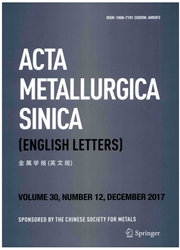

 中文摘要:
中文摘要:
Nanoporous silver(NPS) with a ligament size ranging from 15 to 40 nm was fabricated by de-alloying(Cu50Zr50)100-xAgx(x = 10at%, 20at%, 30at%, and 40at%) amorphous ribbons in a mixed aqueous solution of hydrofluoric(HF) acid and nitric acid under free corrosion conditions. Nanoporous silver ligaments and pore sizes were able to be fine-tuned through tailoring the chemical composition, corrosion conditions, and de-alloying time. The ligament size increases with an increase in Ag content and de-alloying time, but decreases with an increase in HF concentration. This phenomenon may be attributed to the dissolution of Zr/Cu and the diffusion, aggregation, nucleation, and recrystallization of Ag, leading to an oriented attachment of adjacent nanocrystals as revealed by TEM analysis.
 英文摘要:
英文摘要:
Nanoporous silver(NPS) with a ligament size ranging from 15 to 40 nm was fabricated by de-alloying(Cu_(50)Zr_(50))_(100-x)Agx(x = 10at%, 20at%, 30at%, and 40at%) amorphous ribbons in a mixed aqueous solution of hydrofluoric(HF) acid and nitric acid under free corrosion conditions. Nanoporous silver ligaments and pore sizes were able to be fine-tuned through tailoring the chemical composition, corrosion conditions, and de-alloying time. The ligament size increases with an increase in Ag content and de-alloying time, but decreases with an increase in HF concentration. This phenomenon may be attributed to the dissolution of Zr/Cu and the diffusion, aggregation, nucleation, and recrystallization of Ag, leading to an oriented attachment of adjacent nanocrystals as revealed by TEM analysis.
 同期刊论文项目
同期刊论文项目
 同项目期刊论文
同项目期刊论文
 期刊信息
期刊信息
